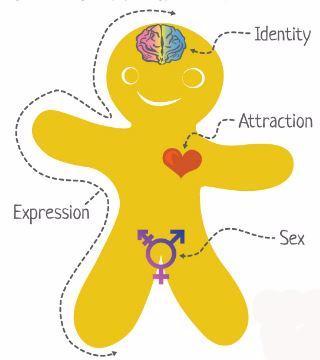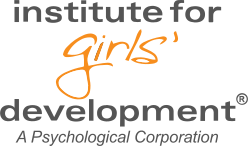
By: MARY SCHULTZ, MMFT
Licensed Marriage and Family Therapist (LMFT 110506)
Erin Norton, PsyD – Registered Psychological Assistant (PSB94025827) Supervised by Vicki Chiang, Psy.D., (PSY21136) facilitates Rainbow Grit at the Institute, our group for LGBTQ youth.
It might be safe to assume you’re wearing clothes today. But were you consciously aware of the sensation of the fabric against your skin until we brought it to your attention? Probably not. That’s just how the brain works, by moving things to the background that are not immediately important; moving things that don’t need to be in the front of our consciousness. Gender can be similar for most people: something that seeps out of our awareness if it does not seem high-priority. But even if we do not always think about it, gender (and all the things that go with it), affects us all every day, from the clothes we wear to the jobs we work or the extracurriculars in which our kids engage. This is the first in a two-part series in which we will provide a brief introduction to gender and sexuality definitions and education.
Definitions and Moving Beyond Binary:
Gender identity is part of identity development for all children. Many children’s gender identity matches the sex they were assigned at birth. For some children, their gender identity does not match the sex they were assigned at birth. In order to help our kids become savvy enough to develop their own identities and critique social messages, it’s important to understand some definitions. One of the things we often find in conversations with teens and with parents is about identity paths. Some of the questions we often hear from parents and educators include: “What’s the difference between sexual orientation and gender identity?” “What’s the difference between gender identity and biological sex?” “My teen was talking about gender expression – and I don’t know what that means.” “My teen says they are non-binary and I really have trouble getting my head around this idea of a gender continuum, rather than either/or, male/female.” The handy Genderbread Person illustration can be very helpful in clarifying these nuanced concepts (link provided below).
Gender: The way a culture and society views each sex. What it means to be masculine or what it means to be feminine (i.e. gender roles).
Biological sex: Physical characteristics like external genitalia, internal reproductive organs, sex hormones, sex chromosomes, and gonads. At birth, doctors use these characteristics to assign such labels as male, female, or intersex.
Gender Identity: The way an individual views or experiences their gender. This identification can fall along the ever expanding gender spectrum of male, female, both or neither. Someone’s gender identity can be based on their biological, legal, and/or social identity, whatever they feel represents them best.
The gender spectrum can include identifications such as:
• Male
• Female
• Cisgender
• Genderqueer
• Non-binary
• Gender Nonconforming
• Gender Fluid
• Bi-gendered
• Two Spirited
• Genderless
• Third Gender
• Transgender
• Gender Variant
• Masculine of center
• Feminine of center
Gender Expression: How we express our gender through external or physical modes such as how we dress, do our hair, move our bodies, or speak (our mannerisms). Gender expression can be a positive and liberating way to express yourself, and it can also be used by others to make assumptions about an individual.
For many years the dominant culture in the US has adopted and promoted a binary world view – one that emphasizes “opposites” and maybe even pits these opposites against each other: male and female, masculine and feminine. However, current research and sociological and psychological understanding tells us two things. First, these binary opposites are an inaccurate representation of the experience of a vast group of people outside the “gender norm.” Second, it does not serve our developing children to provide them with an inaccurate and oversimplified understanding of gender, no matter where they are on the gender continuum. Examining individual gender identity is benefical for all kids, not only our LGBTQIA “gender variant” ones. Many of us want to teach the kids in our lives ways to be inclusive, compassionate, and kind. We want to equip youth to critique and resist sexism, homophobia, and misogyny. One important step is to be given a language to identify, express, and examine their own gender identity – and to understand others’. Education can – and often does – breed compassion for both self and others. Helping kids through the ongoing process of gender identity development is an investment both in their future, and in the future of a more equitable world.
Resources:
Genderbread Person: An Edugraphic for examining and understanding gender and sexuality spectrums. From “It’s Pronounced Metrosexual,” a website with lots of very helpful information
http://itspronouncedmetrosexual.com/2015/03/the-genderbread-person-v3/#sthash.Nu09kB1H.dpbs
Transforming Family, “a Los Angeles based family support group creating a positive environment for children, adolescents and their families to explore issues of gender identity.”
http://www.transformingfamily.org/
The Gender Spectrum:
https://www.genderspectrum.org/quick-links/understanding-gender/
GLAAD
http://www.glaad.org/reference/transgender
Human Rights Campaign
http://www.hrc.org/resources/sexual-orientation-and-gender-identity-terminology-and-definitions
The Trevor Project
http://www.thetrevorproject.org/pages/trans-gender-identity
